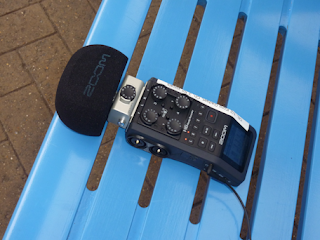While I want to be quite strict about only working on one track of Chronicles of a Dead End at a time, I've already had to renege on that just a little bit. It just so happens that the holiday from which I have now returned, was my first post-2020 visit to the real-life place that, in part, inspired "Faraway Island" - a sprawling song that will be track 2 this time. And I decided to bring my recording equipment with me, hoping to capture some sound effects to use in the song. The trip proved a fruitful one, but before I go into detail I'd like to recap the two previous versions.
The Escapade version of "Faraway Island" begins and ends with what sounds like static filtered through beach noises. That's, in fact, basically what it is: I generated some white noise, then filtered it using the PSR-5700's "seashore" effect as an impulse. (This is essentially the same technique that I used to generate a synthetic "choir" based on my voice in that album's version of "March for the Age".)
The Escapade 2 version, then, features stock Jupiter-80 sound effects at 4 points: a "train" sound during the slightly re-worked intro, which is repeated after the long instrumental "C" section, plus "wind" at the start of "C" and "running water" at the very end. Based on this evidence, I have come to believe that this kind of stock sound effect is only really useful for comedic effect. This song is definitely not meant to be funny!
Nonetheless, the Chronicles version will be mainly taking 2 as its structural model, as I think I was basically on the right track in thinking that "C" could use more stuff adding to it, lest it grind the track's pace to a halt.
 |
| Not to be confused with the now-infamous video-conferencing platform. |
First, I captured a few minutes of the ambience of a not-particularly-busy railway station. It rapidly became clear why the "train" sound effect sounds so jarringly out of place in the Escapade 2 version: real-life trains sound nothing like it! I'm already pretty sure I know exactly which part of the recording I'll be using - taking great care, of course, to make sure that no clear voices are discernible in the finished track. For the intro, I plan to combine this with the heavily-echoed, staccato piano chord from the Escapade version and the pre-echo of "C" with which I replaced it for 2.
Second, for the "C" section itself I decided to record actual seashore sounds. Finding a good spot to set up my equipment proved challenging, but it was worth it for an extraordinary stroke of good fortune. About 40 seconds after I hit "record", a seagull started up a plaintive song, which then developed into a remarkably intricate duet. This was an incredible, mind-expanding experience, as it's the first time I've appreciated for myself the complexity and expressiveness of birdsong, even if as humans we can't fully comprehend it. I understand, at last, why so many composers (most famously Messiaen) have been entranced by it.
Finally, for the very end of the track I recorded the much gentler sound of a stream trickling over some pebbles. I have to give the Jupiter-80 some credit: the "running water" sound effect that ends the Escapade 2 version of "Faraway Island" does sound remarkably similar to what I ended up with.
As I have yet to record anything else for this song, it remains to be seen exactly how these will fit into the final arrangement. Still, this is really exciting!
No comments:
Post a Comment
Note: only a member of this blog may post a comment.